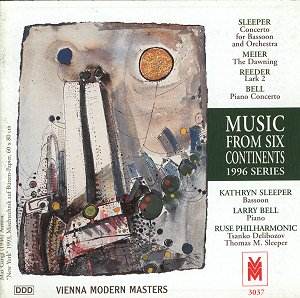All the composers, but one, featured in this release
are new to me. In fact, Larry Bellís name may be somewhat more familiar
since some of his music is available in commercial recordings (among
others on VMM 3016 and on NORTH/SOUTH RECORDINGS).
Sleeperís large-scale and ambitious Bassoon Concerto
was written for Kathryn Sleeper (his sister?) and first performed by
her in August 1993 in Beijing. It is in three substantial movements
(Faust and Psyche, Eros and Psyche and Prometheus and Psyche)
though we are not told to what extent the titles relate to the content
(or the other way round?). The first movement is roughly in sonata form
with an extended accompanied cadenza. The second movement, mostly song-like
in character though with a more animated central section, is scored
for harp and strings. A paraphrase of a song of Praetorius is woven
into the music. Soloist and full orchestra join again in the virtuosic
final movement ending "with a wild rush to octave C sharps".
This is a fine work, though a bit too long for its material, and in
any case a superb showpiece for a much neglected instrument. It is a
most welcome addition to the limited contemporary repertoire of bassoon
concertos and well worth hearing.
Larry Bell, who has also composed a bassoon concerto
The Sentimental Muse Op.45 for Kathryn Sleeper, is the
soloist in this performance of his substantial Piano Concerto
Op.33 completed in 1989. It is in three movements of which the
titles (Lyrical and Majectic, Blues Theme with Variations and
Dancelike and Driving) give a fair description of the music.
It is to be noted, however, that the "blues theme" is an original
tune. The Finale is a brilliant, dance-like movement full of energy
and bouncing rhythms. Those of you who may already have heard some of
Bellís works will know what to expect. As I already mentioned in earlier
reviews, Bellís music is some sort of updated Americana breathing the
same air as Coplandís or Ivesí music. It is colourful, often warmly
tuneful and rhythmically alert, direct and communicative. A fine work
though his Sacred Symphonies Op.23 (on VMM 3016) is a
much finer work and probably the best introduction to Bellís endearing
music.
Margaret Meierís The Dawning has an almost
concertante part for celesta (representing "the innocence and promise
of young life"). The slowly burgeoning life depicted in the slow
introduction reaches a first climax (birth). There ensues a slow, haunting
melody (actually "a 12-note row and its inversion") unfolds
reaching a playful section followed by a short set of variations leading
to a full restatement of the main theme as a powerfully assertive coda.
A beautiful, attractive work that repays repeated hearings.
Australian-born Haydn Reederís Lark 2
for saxophone and orchestra is actually the third version of a song
originally part of the song cycle Songs of Love and Terror
for mezzo-soprano and chamber ensemble. (Lark 1 is a setting
for mezzo-soprano and orchestra whereas Lark 2 is a song-without-words
for saxophone and orchestra.) The text of the original vocal setting
is by the 12th Century French poet, Bernart de Ventadorn
(some of this troubadourís poems have also been set by John Buller in
his wonderful Proença once available on UNICORN).
I do not know the vocal settings and, therefore, have no idea of how
the saxophone setting relates (or does not) to the song. Lark
2, however, though in a slightly more advanced idiom than any
of the other pieces here, is nevertheless a quite attractive piece of
music in its own right. I would now welcome an opportunity to hear either
the song cycle or Lark 1 some day.
An interesting instalment in VMMís ongoing series Music
from Six Continents with two substantial, if somewhat uneven works
and two shorter, attractive pieces, all in fine performances decently
recorded.
Hubert Culot







